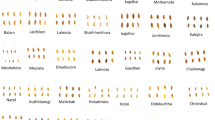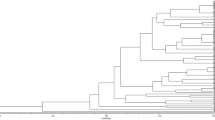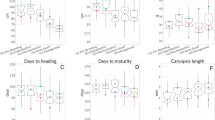Summary
A representative group of 190 rice types collected from North-East India along with four standard varieties, three of which were indicas and one japonica, was studied to understand the nature of genetic divergence. Preliminary grouping was done by canonical analysis and the resultant 42 groups were further classified using the D2 statistic.
The final grouping resulted in nine divergent clusters. The three indica standards were found in three different clusters indicating the wide available variability among them. The japonica standard formed a separate group by itself. A majority of the North-East Indian types formed clusters with indicas, whereas some were intermediate and still others were closer to japonica or indica, thus indicating a series of intergrades bridging indica and japonica.
Height followed by leaf area was found to be important for primary and 100-grain weight, followed by amylose content for secondary differentiation. It appears that natural selection as well as human selection might have operated for characters differentiating rice types in Assam and North Eastern Himalayas. Geographical distance was not found to be related to genetic divergence. The study suggests that O. sativa contains innumerable but divergent forms, and its classification into definite varietal groups on an arbitrary basis such as isolation barrier, sexual affinity or geographic distribution would be far from reality.
Similar content being viewed by others
Literature
Arunachalam, V., Jawahar Ram: Geographical diversity in relation to genetic divergence in cultivated sorghum. Indian J. Genet. Plant Breed. 27(3), 369–380 (1967).
Ghosh, L., Bhaduri, P. N.: Inter-relationships of subspecies of Oryza sativa as revealed by grain and embryo size. Indian J. Genet. 26, 12–20 (1966).
Govindaswamy, S., Krishnamurty, A.: On the occurrence of japonica type of grains in Jeypore tract. Rice News Letter 6(4), 22–24 (1958).
Hsieh, S. C., Oka, H. I.: Cytogenetical studies of sterility in hybrids between distantly related varieties of rice, O. sativa L. Jap. J. Genet. 33, 73–80 (1958).
Jawahar Ram, Panwar, D. V. S.: Interspecific divergence in rice. Indian J. Genet. 30(1), 1–10 (1970).
Juliano, B. O.: Annual Report of IRRI, Philippines (1971).
Kato, S., Kosaka, H., Hara, S.: On the affinity of the cultivated varieties of rice plants, Oryza sativa L. Kyushi Imp. Univ. Dept. Agr. Jour. 2(9), 241–276 (1930).
Little, R. R., Hilder, G. B., Dawson, E. H.: Differential effect of dilute alkali on 25 varieties of milled white rice. Cereal Chem. 35, 111–126 (1958).
Matsuo, T.: Genocological studies on cultivated rice. Bull. Natl. Inst. Agric. Sci. Japan, Ser. D, 3, 111–120 (1952).
Mizushima, V.: Study on sexual affinity among rice varieties, Oryza sativa L. I. Analysis of affinity of Japanese, American and Javanese varieties. Seibutsu (bd3)(sn2) (Japanese) (1948).
Mizushima, V.: Study on sexual affinity among rice varieties, O. sativa L. II. Affinity of other Asiatic and Hawaiian varieties. Tohoku J. Agric. Res. 1, 151–160 (1950).
Morishima, H., Oka, H. I.: The patterns of interspecific variation in the genus Oryza: its quantitative representation by statistical methods. Evolution 14, 153–165 (1960).
Murty, B. R., Arunachalam, V.: The nature of genetic divergence in relation to breeding systems in crop plants. Indian J. Genet. Plant Breed. 26, 188–198 (1966).
Murty, B. R., Arunachalam, V.: Factor analysis of diversity in Sorghum. Indian J. Genet. 27, 123–135 (1967).
Murty, B. R., Tiwari, J. L.: The influence of dwarfing genes on genetic diversity in Pennisetum typhoides (Burm.) S. and H. Indian J. Genet. Plant Breed. 27(2), 165–212 (1967).
Murty, B. R., Mathur, J. B. L., Arunachalam, V.: Self incompatibility and genetic divergence in Brassica campestris var. brown sarson. Sankhya: Ind. J. Stastics series B. 27, 271–278 (1965a).
Murty, B. R., Anand, I. J., Arunachalam, V.: Sub-specific differentiation in Nicotiana rustica L. Indian J. Genet. Plant Breed. 25(2), 217–223 (1965b).
Oka, H. I.: Influence of intervarietal hybrid sterility on segregation ratios in rice. Jour. Agr. Assoc. China, New Series 1, 13–23 (1953a).
Oka, H. I.: Genetic analysis of intervarietal hybrid sterility. Certation due to certain combinations of “Gametic Development Genes” in rice. Jap. J. Breed. 3(1) 23–30 (1953b).
Oka, H. I.: Phylogenetic differentiation of cultivated rice plant. VI. The mechanism of sterility in the intervarietal hybrids. Jap. J. Breed. 2(4), 217–224 (1953c).
Oka, H. I.: Phylogenetic differentiation of the cultivated rice plant. II. Classification of rice varieties by intervarietal hybrid sterility. Jap. J. Breed. 3(3), 1–6 (1954a).
Oka, H. I.: Phylogenetic differentiation of the cultivated rice plant. III. Varietal variations of the responses to day length, temperature, and the number of days to growth period. Jap. J. Breed. 4(2), 92–100 (1954b).
Oka, H. I.: Phylogenetic differentiation of the cultivated rice plant. IV. Varietal variations of the response to fertilizer in rice. Jap. J. Breed. 4(2), 101–110 (1954c).
Oka, H. I.: Phylogenetic differentiation of the cultivated rice plant. V. Variation of the germination temperature and temperature constant among rice varieties. Jap. J. Breed. 4(3), 140–144 (1954d).
Oka, H. I.: Report of study tour to Thailand for investigation of rice. Report Rocke-feller Foundation 34 (1958a).
Oka, H. I.: Intervarietal variation and classification of cultivated rice. Indian J. Genet. Plant Breed. 18(2), 79–89 (1958b).
Rao, C. R.: Advanced statistical methods in biometric research. New York: John Wiley & Sons 1952.
Richharia, R. H., Misro, B.: Evolutionary tendencies in rice based on genetic evidence. Proc. Nat. Inst. Sci. India (1961).
Sampath, S.: The genus Oryza: an evolutionary perespective. Oryza 3(1), 30–34 (1966).
Sampath, S., Mohanty, H. K.: Cytology of semi-sterile rice hybrids. Curr. Sci. 23, 182–183 (1954).
Sharma, S. D., Vellanki, J. M. R., Hakim, K. L., Singh, R. K.: Primitive and current cultivars of rice in Assam — A Rich Source of Valuable Genes. Curr. Sci. 15(6), 126–128 (1971).
Siddiq, E. A., Swaminathan, M. S.: Mutational analysis of racial differentiation of Oryza sativa. Mutation Res. 6, 478–481 (1968).
Siddiq, E. A., Nerkar, Y. S., Mehta, S. L.: Intra and inter-subspecific variation in soluble protein of O. sativa L. Theoretical and Applied Genetics 42, 351–356 (1972).
Terao, H., Mizushima, V.: Some considerations on the classification of Oryza sativa L. into two subspecies so called ‘japonica’ and ‘indica’. Jap. J. Bot. 10(3), 213–258 (1939).
Terao, H., Mizushima, V.: On the affinity of rice varieties cultivated in East Asia and America. B. Agr. Expl. St., Ministry Agr. Commerce (Japan), 55, 1–7 (1944).
Timothy, D. H.: Genetic diversity, heterosis and the use of exotic stocks in maize in Columbia. Statistical genetics and Plant Breed. Symp. Raleigh, 581–591 (1963).
Williams, P. C., Kuzura, F. D., Hlynka,: A rapid colorimetric procedure for estimating the amylose content of starches and flours. Cereal Chem. 47(4), 411–420 (1970).
Author information
Authors and Affiliations
Additional information
Communicated by M. S. Swaminathan
Rights and permissions
About this article
Cite this article
Vairavan, S., Siddiq, E.A., Arunachalam, V. et al. A Study on the nature of genetic divergence in rice from assam and North East Himalayas. Theoret. Appl. Genetics 43, 213–221 (1973). https://doi.org/10.1007/BF00309136
Received:
Issue Date:
DOI: https://doi.org/10.1007/BF00309136




